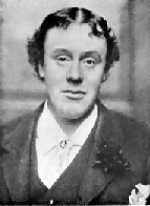Eric Stenbock
Contents |
Brief Bio
W.B. Yeats called Count Stanislaus Eric Stenbock a “scholar, connoisseur, drunkard, poet, pervert, most charming of men,” which is actually an accurate description of Stenbock’s life. Stenbock was born on March 12, 1860 at Thirlestain Hall, Cheltenham to Lucy Sophia, a cotton heiress, and Count Erich Stenbock, count of Borges and baron of Torpa whose aristocratic family extended from Estonia to Sweden and Russia. Stenbock made contributions to literature that were recognized by his contemporaries, but eventually those contributions faded into obscurity. Stenbock attended Balliol College, Oxford in 1879 but after four terms he left without finishing a degree. His father died when he was only one, and his grandfather died in 1885, leaving him the family estate and the title of Count. Stenbock is known for his interesting shifts in religious allegiance: Born Lutheran and later converting to Catholicism, eventually Stenbock syncretically “evolved a religion of his own, compounded of Buddhism, Catholicism and idolatry.” [1] His fascination with religion can be seen in a work like “The Other Side” in which religion is one of the dominant forces in the lives of the characters and in the progression of the narrative. Stenbock died on April 26, 1895 from cirrhosis of the liver. He died in his mother’s home in Withdeane Hall, near Brighton, and was buried on May 1st in Brighton Catholic cemetery.[2]
Writing in the Victorian era, Stenbock “established not only an enduring fin de siècle legend of self-destruction but also numerous friendships with writers and artists, including Aubrey Beardsley [. . . and] Max Beerbohm”[3] Not only did his association with individuals and his lifestyle connect him with the late Victorian movement of aestheticism and decadence, but also his writing which focused on dark topics and critiques of issues like the role and purpose of religion, the nature of sexuality, and what it meant to be queer. “The Other Side: A Breton Legend,” for instance, is an interesting piece of werewolf lore, but more interesting is the way it connects to other Victorian works like The Picture of Dorian Gray and The Strange Case of Dr. Jekyll and Mr. Hyde and Dracula because each work contains supernatural elements and examines notions of sexuality, morality, and identity formation in the context of conservative Victorian ideology.
Bibliography
Poetry
- Love, sleep & dreams : a volume of verse. - Oxford : A. Thomas Shrimpton & Son ; Simpkin Marshall & Co, 1881?
- Myrtle, rue and cypress : a book of poems, songs and sonnets. - London : [privately printed by] Hatchards, 1883
- The shadow of death : poems, songs, and sonnets. - London : The Leadenhall Press, 1893
- On the freezing of the Baltic Sea. - [Privately printed for] Timothy d'Arch Smith, 1961
- The shadow of death ; Studies of death (Degeneration and regeneration : texts of the premodern era). - New York : Garland Pub., 1984
- Love, sleep & dreams : a volume of verse. - Harleston : Hermitage Books, 1992
- Myrtle, rue and cypress : a book of poems, songs and sonnets. - Harleston : Hermitage Books, 1992. - Edition of 60 numbered copies
- The collected poems of Count Stenbock. - London : Durtro, 2001. - Edition of 400 copies. Collects Love, sleep & dreams (1881?), Myrtle, rue and cypress (1883) and The shadow of death (1893). Also includes Ballad of creditors
Short stories
- Studies of Death : Romantic Tales (London : David Nutt, 1894)
- The Shadow of Death ; Studies of Death (Degeneration and regeneration : texts of the premodern era). - New York : Garland Pub., 1984
- The True Story of a Vampire. - Edinburgh : Tragara Press, 1989. - Edition of 110 copies
- Studies of death : Romantic Tales. - London : Durtro Press, 1996 [1997]. - Edition of 300 numbered copies
- The Child of the Soul. - London : Durtro, 1999
- A Secret Kept. - London : Durtro Press, 2002. - Edition of 200 copies, wraps
- The King's Bastard or, the Triumph of Evil. - London : Durtro Press, 2004. - Edition of 200 numbered copies
- The Other Side: A Breton Legend. - The Spirit Lamp Vol. IV, No. 2 (1893-jun), pp. 52-68
Essays
- The myth of Punch. - London : Durtro Press, 1999. - Edition of 120 numbered copies, wraps
Plays
- La Mazurka des Revenants : a serious extravaganza in six parts. - London : Durtro Press, 2002. - Edition of 164 copies, wraps
Biographies and other
- Adlard, John. Stenbock, Yeats and the Nineties ; with an hitherto unpublished essay on Stenbock by Arthur Symons and a bibliography by Timothy d'Arch Smith. - London : Cecil & Amelia Woolf, 1969
- Costelloe, Mary. Christmas with Count Stenbock / [edited by] John Adlard ; frontispiece by Max Beerbohm. -London : Enitharmon, 1980. - Contains letters by Mary Costelloe
- Reed, Jeremy. A hundred years of disappearance : Count Eric Stenbock. - [Great Britain? : J. Reed, 1995]
Notes
- ↑ Qtd in Karl Beckson, ‘Stenbock, Count Stanislaus Eric (1860–1895)’, Oxford Dictionary of National Biography, Oxford University Press, 2004 accessed 3 Nov 2008
- ↑ ibid
- ↑ Qtd in Karl Beckson, ‘Stenbock, Count Stanislaus Eric (1860–1895)’, Oxford Dictionary of National Biography, Oxford University Press, 2004 accessed 3 Nov 2008
